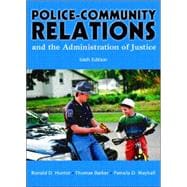
What is included with this book?
| Police-Community Relations: An Overview | |
| Public Relations and Community Relations: A Contrast | |
| Community Policing | |
| The Public and the Police: A Consortium of Communities | |
| Relations Within the Police Organization | |
| Police Role Concept in a Changing Society | |
| Coping With the Human Experience of Being a Cop | |
| The Communication Process | |
| Police Discretion and Community Relations | |
| The Media Link | |
| Special Populations and the Police | |
| Community Relations in the Context of Culture | |
| The Dilemmas of Dissent and Political Response | |
| Conflict Management | |
| Community Control: A Continuum of Participation | |
| Police-Community Relations in the New Millenium | |
| Appendix: Case Studies | |
| Index | |
| Table of Contents provided by Publisher. All Rights Reserved. |
The New copy of this book will include any supplemental materials advertised. Please check the title of the book to determine if it should include any access cards, study guides, lab manuals, CDs, etc.
The Used, Rental and eBook copies of this book are not guaranteed to include any supplemental materials. Typically, only the book itself is included. This is true even if the title states it includes any access cards, study guides, lab manuals, CDs, etc.